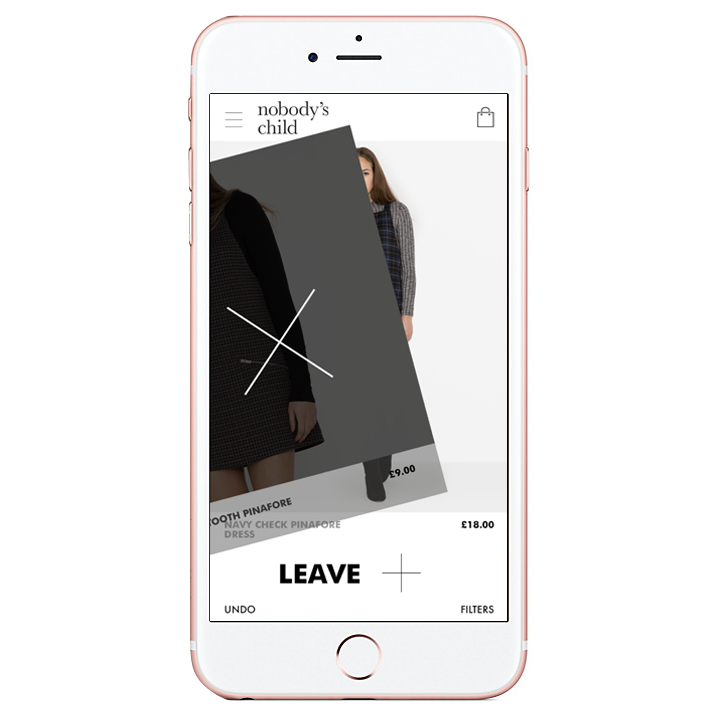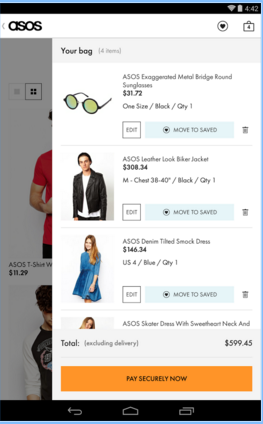Swipe right to buy: E-commerce apps take design cues from Tinder

There’s no guarantee you’ll have a good dating experience on Tinder, but there’s a chance you’ll find a good match on e-commerce apps that share the same interface.
Swipe right if you like an item. Swipe left to take a pass. The simple swipe-yes-or-no design has been widely adopted by mobile apps that offer everything from fashion discovery to grocery shopping.
For instance, you can swipe to buy a pair of Jimmy Choos on Stylect, shop your style type on Blynk or make a restaurant reservation on Nibbly, to name a few. It turns out shopping for a new blouse has a lot in common with browsing for a mate.
More than a “hot or not” game
Beth Wond, managing director for Bijou Commerce, intuitively understood the link and began developing a “Tinder for e-commerce” interface for fashion retailers last year. Over the span of that year, 300 fashion businesses approached Bijou to implement the interface, precisely because it lets shoppers replicate on mobile how they behave in store.
“When you walk through a clothes shop, you quickly flick through each item on the rack and decide what you like or dislike. When optimized, the Tinder swipe brings that shopping experience to mobile,” said Wond.
The Tinder-style interface also simplifies the browsing experience by showing one image at a time, so shoppers are likely to see more products per visit. In comparison, most retail apps present anywhere between four and 12 products on a single screen for the user to choose, which could make it harder for individual products to stand out.

“When the simple, clear swiping mechanics are combined with an optimized checkout process, they can deliver conversion rates three to five times higher than typical mobile site benchmarks,” Wond added.
Daniel Murray, co-founder of fashion shopping app Grabble, decided that “Tinder for fashion” was the best solution for his e-commerce business after his team prototyped in HTML5 a “Tumblr for fashion” and “Twitter for fashion” interface.
“‘Tinder for fashion’ had the best ‘wow’ factor and the [customer loyalty] results, so it was the outright logical choice for us and clear winner for its simplicity,” said Murray.
Grabble processes more than 1.5 million swipes per day and converts 3 percent of its audience to buy, while most online retailers struggle to get 2 percent, according to Murray. Those swipes offer valuable data for Grabble on what its users like (and mostly what they dislike), so the brand can be more targeted. Murray also told Digiday that a lot of the data is anonymized and shared with Grabble’s advertising clients that run advertorial-style ads on the app.
A short-lived trend?
While “Tinder for e-commerce” is considered a wise investment by entrepreneurs like Wond and Murray, it doesn’t convince Ryan Matzner, director for Fueled.
An app maker, Matzner doesn’t get why so many e-commerce companies are jumping onto the Tinder bandwagon without considering if it’s a good fit with their business. Swiping right on a photo of someone attractive and finding out they are interested in you as well is personal and flattering, but a product cannot like you back.
“It’s a horrible fad. Shopping is different from dating because a product cannot talk to you,” said Matzner. “Missing that dosage, these apps need to have additional utilities aside from discovery.”
Moreover, swiping through cards on an app is an easy way to discover products but isn’t good for search. First and foremost, mobile shopping is about shopping in short snippets of time when the user is in bed, on a plane or waiting for a train, so retailers should allow users to browse and search in a highly efficient way.

As an alternative, Matzner pointed to the ASOS app, with its clean look and utilitarian features, as a model that retailers should be emulating. Its search tool allows shoppers to look for and filter items by type, size, brand, price and color. Shoppers can also watch catwalk videos for clothes, shoes and accessories within the app.
Flirting with other alternatives
It’s unclear if “Tinder for e-commerce” will become a broader mobile user interface standard, but there are many designs that retailers can take advantage of, according to David Hewitt, vp for consumer experiences and the global mobile practice lead for SapientNitro. For example, the new 3D Touch feature on iPhone 6s and 6s Plus lets the users press on an app and see the shortcut that they want to use, which is an elegant gesture-based enhancement to optimize viewing item details.
Related, the touch-friendly carousel ads that Facebook and Instagram allow retailers to present multiple product views of an otherwise static ad in a social news feed, he said. E-commerce businesses should explore more possibilities and experiment with different mobile interfaces as long as they make shopping fun, simple and enjoyable.
“We aren’t married to [Tinder] at all. We will go with whatever user experience defends our position best and enables our customers through the best possible experience at the given time,” said Grabble’s Murray. “Swiping is not something we’ll stick with eventually, but for now it works well.”
More in Marketing

Ahead of Euro 2024 soccer tournament, brands look beyond TV to stretch their budgets
Media experts share which channels marketers are prioritizing at this summer’s Euro 2024 soccer tournament and the Olympic Games.

Google’s third-party cookie saga: theories, hot takes and controversies unveiled
Digiday has gathered up some of the juiciest theories and added a bit of extra context for good measure.

X’s latest brand safety snafu keeps advertisers at bay
For all X has done to try and make advertisers believe it’s a platform that’s safe for brands, advertisers remain unconvinced, and the latest headlines don’t help.





